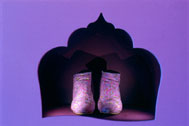




 |
    |
Biography |
||
|
|
Building Cupolas in the SkyThe Art of Carolinda Tolstoyby Jane Watt To achieve integrity, balancing the artistic image and the creative process itself is a far from easy process, requiring not only concentrated determination and deep self-belief. All of the above can certainly be applied to the artistic credo of Carolinda Tolstoy. Carolinda's creative world relates to the ancient past of Middle East and Asia: the Persian renaissance of Safavid period (1571-1722); the best examples of Turkish Iznik ceramics and lacquered painting of ancient Russia. The rulers of Safavid dynasty originated in Azerbaijan and conquered the vast territories of Anatolia, Syria, Upper Mesopotamia and the Armenian mountain districts. They were instrumental in creating the powerful and prosperous Persian Empire. The Persian Renaissance reached its peak in the 17th century and thanks to the foreign merchants received worldwide acclaim. Intricate Persian carpets with Arabic and Chinese ornaments and miniature paintings became the main export from Persia. Turkish Iznik - Nicea during the Greek and Byzantine periods is renowned for its pottery craftsmanship and artistry. The technology of pottery glazing and dying has been passed down from generation to generation. In 15th century the unique qualities of Iznik pottery received wide international acclaim and the works became precious collectors' items. Later the craft went into decline. The year 1989 was proclaimed as the International year of Iznik pottery and great efforts were put into saving the legacy of the old tradition. The lively white and blue with gold motives of Iznik pottery are revived in the modern lines of Carolinda Tolstoy's designs. Professor Ernst Grube of the University of Venice, President of the Islamic Fine Art Foundation in New York, has hailed her work as a contemporary branch which continues this ancient art of Persian pottery. The artist does not base her work solely within tradition but creates new contemporary versions of it. The artist prefers the freedom of abstract forms but some of her works like Persian Dream feature delicate figuration. Carolinda Tolstoy's works are influenced by Persian miniature paintings and illustrations to the old books: 'Lovers' and 'A Woman under the Tree' are penetrated by a quiet harmony of lyricism and intimacy of feeling. Implicit and multi-layered meaning, unuttered eternal truths proper to the Art Orient are to be found in the artist's work. During the first meeting with Carolinda I became struck by an exceptional exoticism of her own image: a striking woman with long raven hair, almond-shaped eyes straight out of a classic Greek vase. She inhabits her own world - her art, dress, gold painted shoes and exquisite oriental necklaces present a picture in itself. Carolinda's works, studio and house evoke mystery, transporting the visitor back to the ancient Orient. Her most recent project is a total house refurbishment in order to accommodate and display her pottery, thus turning it in a mystical museum, an oriental Palace of One Thousands and One Nights where mundane living is left behind for the sake of art. The sketches indicate it will be something extraordinary. Russian culture has been always present in the life and art of the artist, linked to the noble and distinguished Russian family of the Tolstoy's. She took an active role in the Russian Orthodox Church construction project in Chiswick, which led to a new, Russian direction - a series of works titled Cupola in the Sky. The Golden Russian Cupola, a symbol of ancient Russian Empire and Orthodoxy and a close relative of the luxurious Byzantine temples, has been of particular interest to Carolinda since she visited Russia and the Central Asian republics. "Cupolas in the sky is one of my main series of works. It reflects my fascination for the colourful skyline of Russian cities with the festive glitter of the golden domes on churches and cathedrals. Light blue-green overtones and the incredible serenity of the Russian countryside provide a refreshing background for the intricacy of the architectural detail and extensive use of gold. It is there that Russian fairy tales (Skazki) can come alive and give me inspiration to create." Visits to the holy places around Moscow, Zagorsk and Troitsko-Sergievo have had great influences on the artist who is keen to stress the influence of Persian school of miniature paintings upon the ancient school of traditional Russian lacquer art à la Palekh, Kholui and Fedoskino. There are certain undeniable similarities: the extensive use of gold paint and mother-of-pearl, the bright and vibrant colours, the elaborate and detailed drawings that are so untypical of the subdued European school at the time. Carolinda Tolstoy's latest works were created following her travels and meeting with a Russian monk, Fr. Alexandre, seer and calligrapher and, perhaps, the first Internet-based monk to deliver his sermons and publications in virtual space. A new creative project was born on the boundaries of ancient Muslim and Christian religions and is an attempt at uniting both traditions for mutual enrichment. Carolinda Tolstoy believes that one of the most important tasks of her art is to serve as a link between cultural heritages of different peoples. Her works can be seen in galleries in the Middle East, in Istanbul, as well as in the collections of London School of Oriental and African Studies (SOAS), the Traditional Fine Art Foundation (VITA) and permanently in the The Garden of Eden Gallery at 36a Kensington Church Street in London. Recently the Syrian Cultural Centre in Paris hosted an exhibition of her new works. Luke & A gallery in London is to show Tolstoy's work from 14 October - 1 November 2003 |

|
| © Carolinda Tolstoy 1999-2018 | Web site design: QuincDigital |